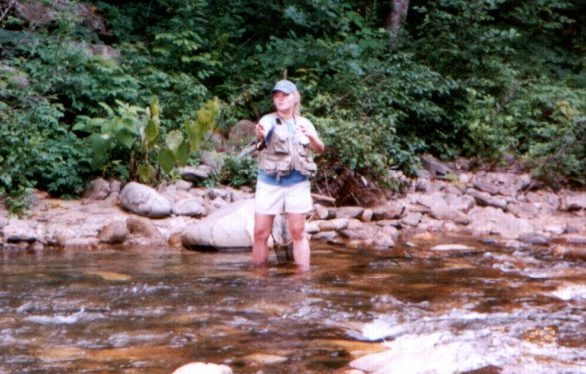Trout fishing in the fall

There’s really nothing quite like trout fishing for immersing yourself in nature and becoming part of the landscape. Cool mountain waters swirl around your feet as you gingerly pick your way along a stream bottom of smooth stones in hues of copper, slate, and ebony. Whether fly-fishing or spin casting, the moment you feel the tug of a trout on the end of a line is always exciting. Reeling it in, it sparkles and somersaults in the rapids, and if you are lucky the process ends with a successful landing in your net. Many a great day has started and ended in a trout stream.
In North Carolina, we have three trout species: brook, brown and rainbow. However, only the brook trout is native, and it’s not actually a trout, but instead a type of char. All three are beautiful fish, but I’m partial to the brook with its teal and red spots and squiggly camouflage worm-pattern on top. In the fall, the brook’s underside turns vibrant orange, to blend in even more with its surroundings.
Before you go trout fishing, you need to know several regulations. These include allowable size, time period, and the lure type allowed. The N.C. Wildlife Resources Commission has recently created a trout fishing web page with maps and regulations (click here).
Hatchery-supported trout waters are stocked periodically to support anglers. Hatchery-supported streams in season have no size limits or bait restrictions but have a limit of seven fish per day.
Wild trout waters, where trout are prolific enough to reproduce naturally, have no closed season but have a minimum size of 7 inches and a limit of four fish per day. Fishing in these wild trout waters can be done only using a single hook and artificial lures. This time of year many trout waters are in delayed-harvest: trout can be caught but not kept, and only on artificial lures with a single hook.
Last spring, some friends and I headed to Boone for opening weekend of the season for hatchery-supported trout waters. We spent the three-day weekend trout fishing and traveling to various streams including Meat Camp Creek, Laurel Fork and the Middle Fork of the New River. It was a wonderful way to spend the weekend, and something we hope to do for years to come. Fishing, like many outdoor activities, is a nice experience by yourself but more fun when shared with friends.
This article is dedicated in memory of Jeffrey Weeks, my high school teacher, mentor and friend. He was an avid fisherman, and taught me a lot about journalism, writing and life.